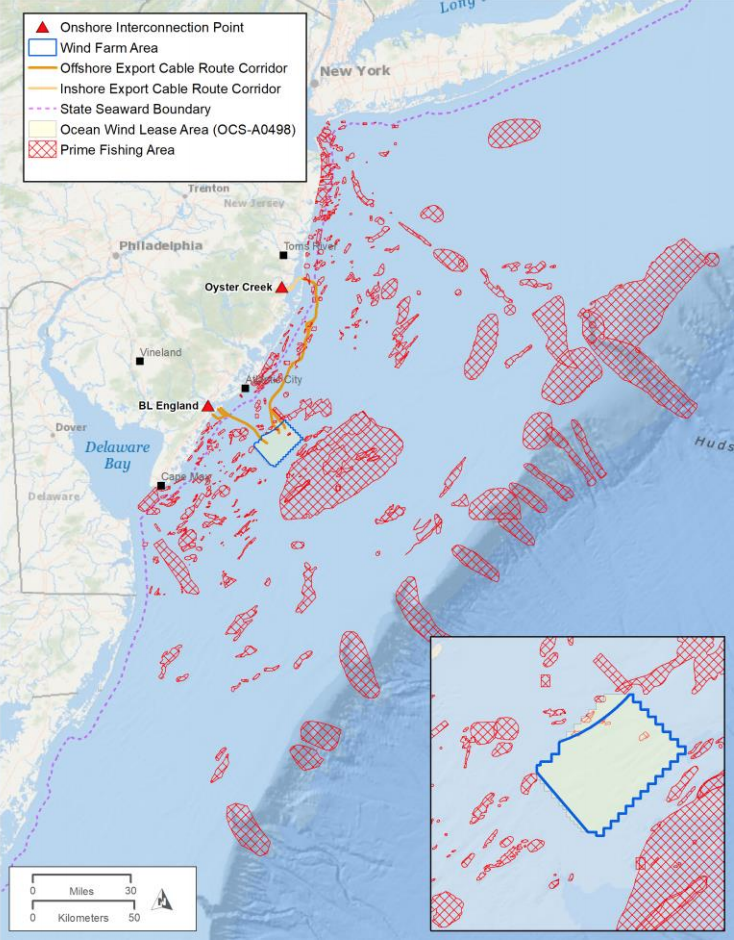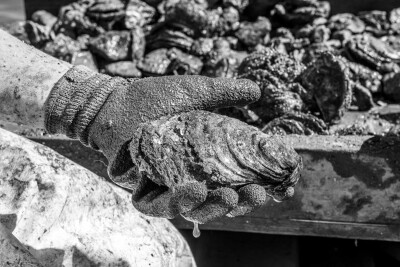Developers of the first New Jersey offshore wind project say they will spend almost $13 million for fisheries monitoring surveys in cooperation with three universities.
Ocean Wind 1, an 1,100-megawatt project 15 miles off Atlantic City, N.J., now includes a fisheries monitoring plan developed along guidelines from the federal Bureau of Ocean Energy Management, according to a statement Wednesday from wind developers Ørsted.
The plan is built around a suite of seven monitoring projects with Rutgers University, Delaware State University and Monmouth University. One will be a first-of-its-kind study for U.S. offshore wind, using environmental DNA from ocean sampling to monitor and assess local fish abundance and biodiversity in the Ocean Wind 1 lease area.
Research work has begun before construction and will proceed at sea on local commercial fishing vessels, during six years through project construction and after.
“The research and data obtained will help to establish a baseline for monitoring potential impacts associated with the development and operations of offshore wind,” according to the developers.
“Ørsted funded similar research through an independent scientific contractor, Inspire Environmental, to study pre-construction, construction, and operational impacts to fisheries resources at America’s first offshore wind farm, Block Island Wind. The results from that trawl study were published in March of 2022 and found no major adverse impacts to marine life throughout the process.”
The five-turbine, 30 MW Block Island pilot project began in 2016 and became an attraction for recreational fishing, with black sea bass and other fish drawn to the new underwater structure.
The scale and impact of Ocean Wind 1 on fisheries is a subject of intense debate.
Recent studies from Rutgers researchers found that planned wind turbine arrays could displace the Mid-Atlantic based surf clam industry enough to reduce its revenue by 15 percent. That loss could be as much as 25 percent for boats based at Atlantic City, a historic hub for the fleet, the researchers estimated.
Ørsted says the fisheries monitoring program will have broad benefits for U.S. offshore wind development.
“We are thrilled to conduct this environmental monitoring with such a highly qualified research team and their fishing industry partners,” said Gregory DeCelles, a senior environment and permitting specialist with Ørsted Offshore North America. “This important study will collect a wealth of valuable data on important commercial and recreational species and can serve as a model for accomplishing fisheries monitoring at offshore wind sites on a regional scale.”
Scientists at Rutgers and Monmouth chose the fisheries monitoring methodologies they saw as most appropriate for the lease area.
Those will include trawls, baited remote underwater video cameras and chevron fish traps. Other technologies put to the task will be autonomous underwater gliders, towed video cameras, and mobile and passive acoustic telemetry.
One trawl survey is modeled on the Northeast Area Monitoring and Assessment Program (NEAMAP). Begun as a pilot program in 2006, NEAMAP was developed by the Atlantic States Marine Fisheries Commission to coordinate fisheries-independent monitoring in the Northeast, focusing on nearshore waters that federal and state survey did not always cover.
Years of NEAMAP sampling by Virginia Institute of Marine Science on the Wanchese, N.C.-based trawler Darana R helped fill huge data gaps to guide fisheries management. For the Ocean Wind 1 monitoring, the survey methodology will be paired with the use of environmental DNA – or eDNA – to assess fish species composition in the project area, from siting and survey work through operations and maintenance.
The use of eDNA technology allows scientists to track the presence of fish species that don’t turn up in sampling trawls, by identifying distinctive genetic material that sloughs off the slime coating on fish. It’s increasingly used as an innovative and inexpensive way to monitor and assess fish abundance and diversity.
The Monmouth University team will handle the eDNA work “to determine whether the development of wind turbines and infrastructure has an impact on fish populations,” according to Ørsted. “Those genetic materials include cells and bodily fluids that fish leave behind when swimming that can be collected, analyzed, and matched to the genetic barcodes of other fish to determine their species.”
Ocean Wind 1 will be the first offshore wind project to monitor for potential changes to fisheries in a wind-energy area using eDNA.
“Sampling for eDNA is especially effective for detecting uncommon, endangered or otherwise hard to catch species in the waters,” said Jason Adolf, a Monmouth University endowed associate professor of marine science and the project co-leader.
“There’s a degree of luck involved in trawling for fish, just as when you cast a line at your local lake,” said Adolf. “The genetic materials in the water can tell you a lot about what you didn’t catch.”
The Monmouth team will sample the waters before, during and after construction for DNA shed by marine life and compare the findings with data gathered through traditional trawls and fish tagging methods.
The studies will take oceanographic data collected with gliders, shipboard observations, and regional ocean observatories to be integrated with sampling “to understand how the abundance and distribution of fish and invertebrate species may be influenced by seasonally dependent ocean stratification in and around the Ocean Wind 1 lease site,” according to Ørsted.
Ocean stratification – the seasonal layering of different subsurface temperature layers – and how wind turbine arrays may interact with them is another question for ocean scientists. Seasonal turnover of those layers is important to the survival of key, commercially important species including scallops and surf clams, and is a driver of primary production and nutrients for the ocean food web.
“The structure of this part of the ocean, the Middle Atlantic Bight continental shelf, is unique among oceanic provinces due to its extreme seasonal temperature range and vertical layering. Migration and ranging are an important part of fish life cycles here as a result, and this makes it challenging to tease out responses to the wind farm specifically,” said the lead principal investigator Thomas Grothues, an associate research professor in the Department of Marine and Coastal Sciences of Rutgers-New Brunswick’s School of Environmental and Biological Sciences.
“It will be different than European and even Block Island offshore wind farms,” said Grothues. “But this study is ambitious and comprehensive enough to tackle this challenge and should yield a trove of data that would be hard to get through any other kind of project.”







